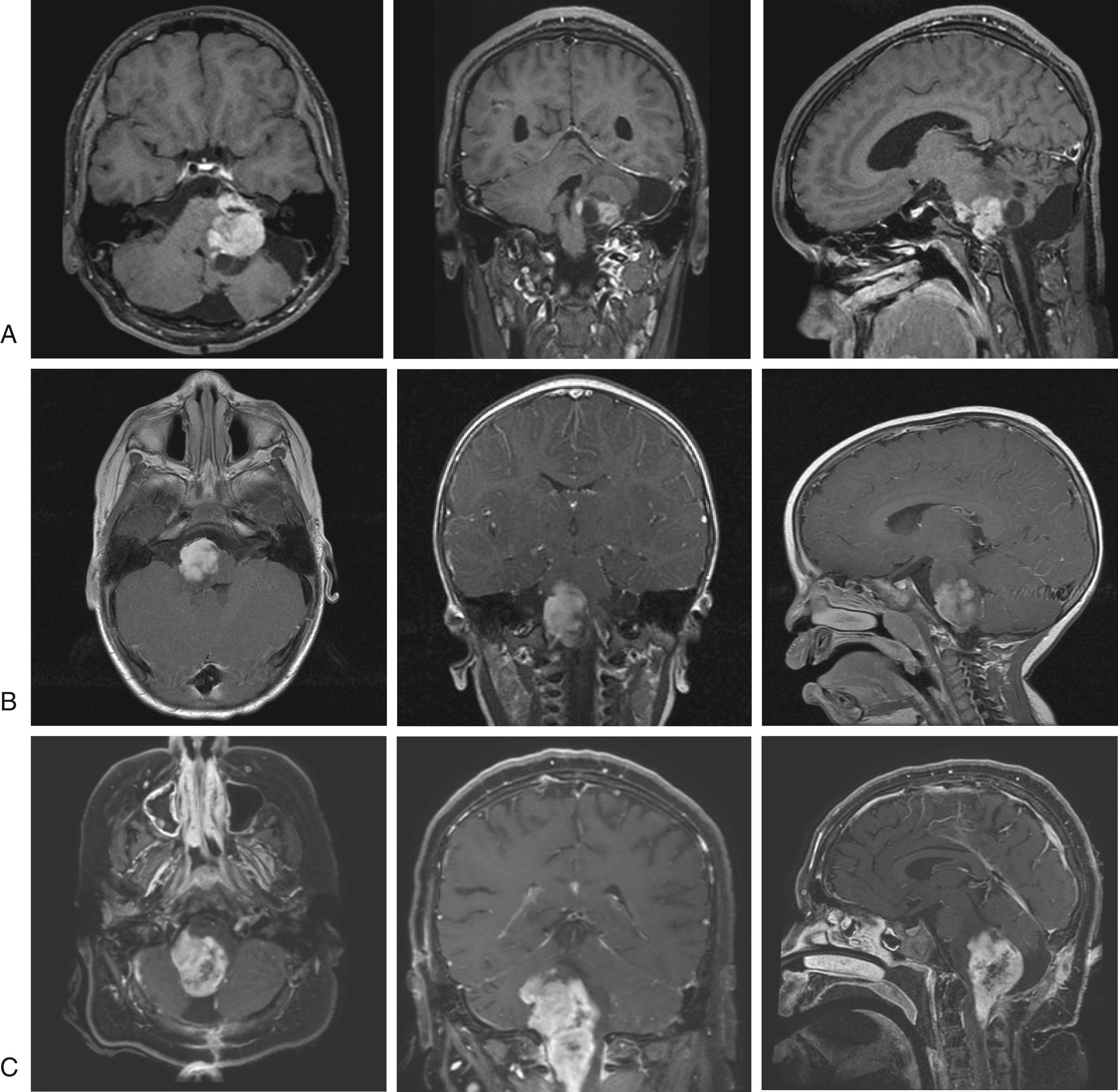Physical Address
304 North Cardinal St.
Dorchester Center, MA 02124
Primary brainstem tumors represent 10% to 20% of all pediatric central nervous system (CNS) neoplasms and 20% to 30% of posterior fossa lesions, where their incidence is surpassed by cerebellar pilocytic astrocytoma (PA), medulloblastoma, and ependymoma. The overwhelming majority of these brainstem tumors are what was until recently known as diffuse intrinsic pontine gliomas (DIPG) , which account for up to 80% of pediatric brainstem tumors, and carry a grim prognosis. , , The remaining 20% comprise a heterogeneous family of glioma variants, which various authors have recommended organizing along anatomic, pathologic, and radiographic lines. , The most common classification specifies five major anatomic categories—tectal/mesencephalic, DIPG, focal, dorsal exophytic, and cervicomedullary. Although this schema and others may be helpful in compiling a differential diagnosis or teaching an approach to treatment, recent advances in our molecular understanding of these tumors allow for a relative simplification into two broad phenotypic categories, which can then by classified by clinical behavior and genetic profile features that are significantly more likely to inform prognosis, decision-making, and perhaps in the near future, individualized treatments.
Routine radiographic and histologic assessments can usually distinguish low-grade glioma (LGG) from high-grade glioma (HGG) , the distinction that has the most significant bearing on the overall approach to defining a comprehensive treatment plan. Driver mutations in pediatric brainstem LGG are predominantly associated with the BRAF family of mutations. , Although there is considerable overlap in the mutation profiles of the major histopathologic diagnoses—particularly when examined by anatomic location, which may play a role in differential gene expression—brainstem pilocytic astrocytoma and pilomyxoid astrocytoma (PMA) frequently express the KIAA1549-BRAF fusion protein, whereas the BRAFV600E mutation is highly prevalent in diffuse low-grade glioma, tectal plate glioma (TPG) , and ganglioglioma . Clinically, most LGG are phenotypically indolent, and therefore potentially amenable to watch-and-wait strategies; however, tumor-directed treatment is frequently indicated, and surgical resection is almost always the preferred primary treatment, with additional interventions potentially required at various points in the natural history for tissue diagnosis, treatment of hydrocephalus, or debulking, as described in detail later.
By contrast, pediatric brainstem HGGs are increasingly defined by the mutation status of H3K27M , which most commonly involves the histone H3.3 gene, H3F3A , but also can occur on the histone H3.1 genes, HIST1H3B and HIST1H3C . In midline gliomas, the H3 mutations almost universally result in the H3K27M mutation ( H3K27I has been reported) and a corresponding loss of H3K27 hypomethylation. The H3K27M mutation results in a broad epigenetic reprogramming that includes changes to numerous histone lysine residues and other nearby serine residues. Indeed, these mutations have been recognized as critical to the understanding and possible treatment of the entity formerly known as DIPG, such that the WHO reclassified it and related diagnoses under the headings diffuse midline glioma, H3K27M-mutant and - wild-type . Clinically, histone H3 mutations occur in 70% to 95% of midline pediatric HGG , and are associated uniformly with a poor prognosis; however, they are also the focus of considerable translational research, particularly drug discovery efforts, which may have significant patient care implications both in terms of current clinical trial eligibility, and future indications for targeted therapies. ,
PA is the quintessential focal brainstem tumor of childhood, accounting for more than half of all low-grade pediatric brainstem neoplasms. Although classically described as a cystic tumor with a vividly enhancing mural nodule in the supratentorial or cerebellar compartments, PA in the brainstem may present at an earlier phase in the natural history or with a less stereotypical appearance, and therefore may be challenging to distinguish from other forms of LGG ( Fig. 70.1A ). Under such circumstances, the presence of the KIAA1549-BRAF gene fusion protein strongly supports the diagnosis of PA , as it has been observed in up to 82% of these individuals, as compared to the diffuse low-grade lesions in which it is rarely observed. Interestingly, the fusion may be associated with a more favorable prognosis, as pediatric PAs demonstrating this molecular signature have a longer progression-free survival (PFS) in the postoperative setting after a subtotal resection (STR).

Other pertinent mutations include LHX2 and IRX2 , which are markedly overexpressed in posterior fossa PA. Interestingly, although these mutations are commonplace among brainstem PA , they’re also abundant in DIPG, yet rarely identified in supratentorial PA or HGG, a finding that has been invoked in support of the existence of “gene expression profiles,” or molecular patterns in the mutations driving glial tumor behavior that are independent of histologic subtype.
PA carries a favorable prognosis among pediatric brainstem neoplasms, due to the low histopathologic grade (WHO grade I), clinical indolence, and general amenability to resection. Ten-year overall survival (OS) exceeds 94%, with almost no early mortalities in the first year, and rare poor outcomes associated with tumors in children younger than 2 years. Surgery is the generally the preferred first-line treatment in most cases of PA , and may be curative if a gross total resection (GTR) is achieved; however, it is usually challenging to successfully reach a GTR with these tumors, as they have been shown to have neurons passing through and because of their adherence to nearby critical brainstem nuclei and cranial nerves. Once a tissue diagnosis has been made, they can be safely watched until reoccurrence, or until residual tumor begins to grow. Optimal treatment of recurrence/progression depends largely on the tumor anatomy, aggressiveness, and any morbidity resulting from the primary resection, with consideration given to repeat resection if the tumor configuration is favorable, versus chemotherapy or, in older children, radiation.
Become a Clinical Tree membership for Full access and enjoy Unlimited articles
If you are a member. Log in here